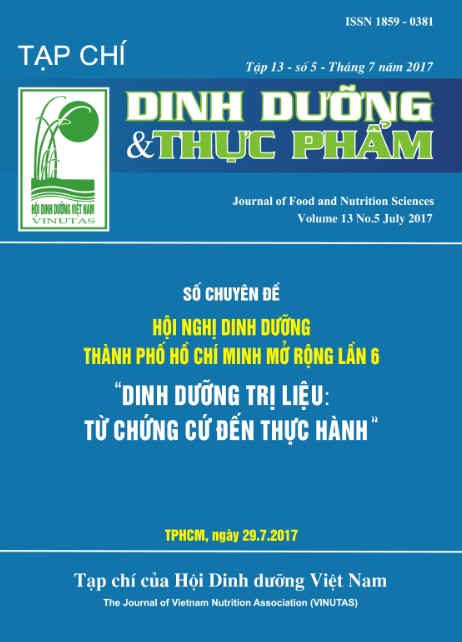TÌNH TRẠNG DINH DƯỠNG VÀ DIỄN TIẾN TRÊN TRẺ 1-59 THÁNG ĐIỀU TRỊ TẠI KHOA HỒI SỨC TÍCH CỰC-CHỐNG ĐỘC BỆNH VIỆN NHI ĐỒNG 1 THÀNH PHỐ HỒ CHÍ MINH
Nội dung chính của bài viết
Tóm tắt
Suy dinh dưỡng phổ biến ở trẻ bệnh nặng và có thể liên quan đến diễn tiến tử vong hoặc thời gian điều trị. Mục tiêu: Đánh giá tình trạng dinh dưỡng trên trẻ bệnh nặng và liên quan với diễn tiến tại khoa Hồi sức Tích cực - Chống độc (HSTCCĐ). phương pháp: Nghiên cứu tiến cứu từ 01/01/2015-30/06/2015 trên 130 trẻ từ 1-59 tháng tại khoa HSTCCĐ Bệnh viện Nhi Đồng 1. Kết quả: Trong tổng số 130 trẻ có 33,8% trẻ suy dinh dưỡng cấp, 33,1% suy dinh dưỡng thấp còi, 36,9% nhẹ cân lúc nhập khoa. Nguyên nhân bệnh gồm các nhóm sốc nhiễm trùng 21,5%, nhiễm trùng nặng 40,8%, tim bẩm sinh 20%, và 17,7% có nguyên nhân khác. Diễn tiến tử vong 17(13,1%) trường hợp, cao nhất ở các nhóm sốc nhiễm trùng (6/21) và tim bẩm sinh (3/26). Sau 7 và 14 ngày điều trị có 31,8% và 10,6% giảm cân >5%. Trung vị (25; 75 pct) thời gian điều trị tại khoa và thở máy là 10 (7; 21) ngày và 8(5; 12,5) ngày. Chưa ghi nhận liên quan giữa tình trạng dinh dưỡng lúc nhập khoa với tử vong và thời gian điều trị hoặc thở máy (p >0,05). Kết luận: Trẻ bệnh khoa HSTCCĐ có 33,8% suy dinh dưỡng cấp lúc nhập khoa và 31,8% sụt cân >5% vào ngày điều trị thứ 7. Chưa ghi nhận liên quan giữa tình trạng SDD lúc nhập viện với diễn tiến tử vong, thời gian điều trị hoặc thở máy, có lẽ do ảnh hưởng của các nguyên nhân bệnh lý khác.
Từ khóa
Suy dinh dưỡng cấp, suy dinh dưỡng mạn, trẻ bệnh nặng, hồi sức tích cực, Bệnh viện Nhi Đồng I
Chi tiết bài viết
Tài liệu tham khảo
2. Zamberlan P, Delgado AF, Leone C, Feferbaum R, Okay TS (2011). Nutrition Therapy in a Pediatric Intensive Care Unit: Indications, Monitoring, and Complications. JPEN J Parenter Enteral Nutr. 35(4):523-529.
3. Trần Kim Cúc, Nguyễn Thị Mỹ Diệp, Nguyễn Thị Thu Hậu (2006). Khảo sát tình trạng dinh dưỡng bệnh nhân nội trú bệnh viện nhi đồng 2 -thành phố Hồ Chí Minh năm 2005. Tạp chí Y học Thực Hành TP Hồ Chí Minh. 10(S2):103-106.
4. Collaborative Group for the Study of Sepsis in PICUs in Beijing Area (2012). Clinical study on sepsis in 2 pediatric intensive care units in Beijing, Zhonghuaer ke za zhi. Chinese journal of pediatrics. 50(3):178-83.
5. Grohskopf LA, Sinkowitz-Cochran RL, Garrett DO (2002). A national pointprevalence survey of pediatric intensive care unit-acquired infections in the United States. The Journal of pediatrics. 140(4):432-438.
6. Mehta NM, Bechard LJ , Cahill N, Wang M, Day A, Duggan CP, Heyland DK (2012). Nutritional practices and their relationship to clinical outcomes in critically ill children—an international multicenter cohort study. Critical care medicine. 40(7):2204-11.
7. Baxter JA, Al-Madhaki FI, Zlotkin SH (2014). Prevalence of malnutrition at the time of admission among patients admitted to a Canadian tertiary-care paediatric hospital. Paediatrics & child health. 19(8):413-7.
8. de Menezes FS, Pons LH, Koch NPC (2013). What are the factors that influence the attainment of satisfactory energy intake in pediatric intensive care unit patients receiving enteral or parenteral nutrition? Nutrition. 29(1),76-80.
9. Bagri NK, Jose B, Shah SK, Bhutia TD, Lodha R (2015). Impact of Malnutrition on the Outcome of Critically Ill Children. Indian J Pediatr. 82:601-5.


